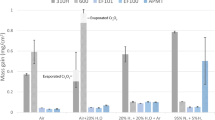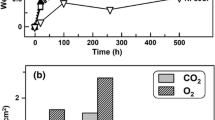Abstract
Moist air containing HCl gas caused the oxide formed on a Ni-Cr-Al alloy at 850°C to crack during the early stages of growth, and extensive blistering and spalling occurred on cooling. In dry air containing HCl gas no oxide cracking was observed at temperature although the oxide blistered and spalled on cooling. In dry or moist air free from HCl an adherent protective oxide formed which did not spall on cooling. The oxide cracking at temperature has been attributed to the production of hydrogen by reaction of Cr and Al in the alloy with water vapor and the removal of NiO as NiCl2 by reaction with HCl gas. Hydrogen produced by reaction of water vapor or HCl with Cr or Al dissolved in the alloy at temperature, but on cooling the hydrogen was released, causing the oxide to blister and spall. Preoxidation of the alloy in HCl-free atmospheres eliminated these effects of HCl gas in short-term isothermal tests.
Similar content being viewed by others
References
H. Boettger and F. Umland,Werkst. Korros. 25, 805 (1974).
J. Stringer and S. Ehrlich, ASME Winter Annual Meeting, Dec. 5., 1976, Paper 76-WA/C04.
J. F. G. Condé and B. A. Wareham, “Gas Turbine Materials in the Marine Environment,” in Proc. Conf. Castine, Maine, Metals & Ceramics Info. Centre, Batelle, 1974, pp. 73–92.
J. A. Goebel, F. S. Pettit, and G. W. Goward,Metall. Trans. 4, 261 (1973).
R. A. Rapp, inMaterials Problems and Research Opportunities in Coal Conversion, Vol. II, R. W. Staehle, ed. (Ohio State University Press, Columbus, Ohio, 1974), pp. 313–334.
R. C. Hurst, S. B. Johnson, M. Davies, and P. Hancock, inDeposition and Corrosion in Gas Turbines, A. Hart and A. J. B. Cutler, eds. (Applied Scientific Pubications, London, 1973), pp. 143–157.
J. A. Waddams, J. C. Wright, and P. S. Gray,J. Inst. Fuel. 32, 246 (1959).
M. K. Hossain and S. R. J. Saunders,Oxid. Met.,12, 1 (1978).
E. W. Washburn, ed.,International Critical Tables of Numerical Data, Vol. 3 (McGraw-Hill, New York and London, 1926), p. 301.
T. G. Dye, A. Fursey, G. O. Lloyd, and M. Robson,J. Sci. Instrum. 1, 463 (1968).
G. C. Wood,Oxid. Met. 2, 11 (1970).
A. J. W. Moore,Metal Surfaces: Structure, Energetics and Kinetics (American Society of Metallurgists, Ohio, 1963), Chap. 5.
P. R. Rowland,Nature 164, 1091 (1949).
H. Mahl and I. N. Stranski,Z. Phys. Chem. 52, 257 (1942).
“MT DATA,” The NPL computational numerical data bank for metallurgical and inorganic substances (National Physical Laboratory, Teddington, Middlesex, England, 1974).
R. J. Fruehan and L. J. Martonik,Metall. Trans. 4, 2793 (1973).
G. W. Rhead and H. Mykura,Acta Metall. 10, 843 (1962).
D. P. Smith,Hydrogen in Metals (University of Chicago Press, Chicago, 1948), Chaps. 5, 6.
H. M. Flower and P. R. Swann,Corros. Sci. 17, 305 (1977).
T. P. Hoar and N. F. Mott,J. Phys. Chem. Solids 9, 97 (1959).
Author information
Authors and Affiliations
Additional information
Sandwich course student at Surrey University.
Rights and permissions
About this article
Cite this article
Hossain, M.K., Noke, A.C. & Saunders, S.R.J. Oxidation of a Ni-Cr-Al alloy at 850°C in air containing HCl gas. Oxid Met 12, 451–471 (1978). https://doi.org/10.1007/BF00612090
Received:
Issue Date:
DOI: https://doi.org/10.1007/BF00612090




